How it all began
Not long after our new neighbours Ernie and Maisie Allen moved in next door, my wife and I were invited to join them and a group of their friends for drinks and nibbles to celebrate Maisie’s 85th birthday. It was a sunny late spring afternoon so we all sat out in the garden and we were soon deep in conversation with a lovely group of people all of whom went out of their way to make us feel welcome. Little did we know at the time that this neighbourly get together would lead, through a series of odd coincidences, to an amazing conclusion that neither Ernie nor I could have dreamed of and in which I am proud to have played a minor yet important role.
It was when one of the guests started a conversation with, ‘Do you remember when we were at Vincent’s, Ernie?’ that my ears pricked up and I was fascinated to learn that both of them had been employed at Vincent Motorcycles in Stevenage in the 1950s. I never progressed beyond a 250cc BSA C11G in my youth but, by coincidence I happen to have an old picture of my father taken in the early 1950s of him sitting astride what I had always thought was a Vincent ‘Black Shadow’ so I nipped back home to get it. On my return, the experts took one look at the bike and shattered my illusions, informing me that it was in fact a Vincent ‘Comet’ or ‘Meteor’ 500cc single and not the 1000cc twin that I had wrongly identified. I know that my dad never rode a motorcycle so he can only have been posing on a mate’s or a relative’s machine, probably with me in a push chair just out of shot. I treasure that picture as it’s one of only a couple I have of him as a young man.
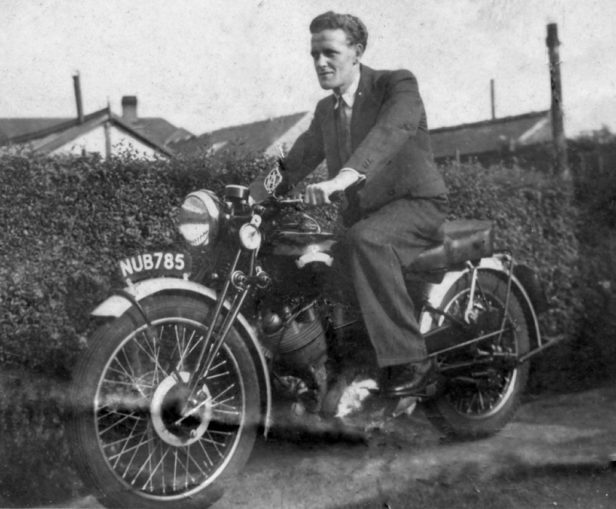
(Photographer and location unknown)
Another little gem was dropped when one of our fellow guests asked, ‘Has Ernie told you that he used to race a Vincent back in the day, Tom? He was very successful; won lots of races.’ At first I thought this was a wind-up but I soon found out that he was being serious. I just had to know more.
A few days later, I got chatting to Ernie who told me more about his time at Vincent’s and his sidecar racing career which, and here’s another coincidence, started over the Easter Bank Holiday weekend 1952 at The Blackburn Aircraft Company’s airfield at Brough in East Yorkshire – where my dad worked in the mid-1950s and Mrs P, then my fiancée, worked in the late 1960s.
A brief history of Vincent motorcycles
Phil Vincent established Vincent Motorcycles in 1928 (the year Ernie was born) when he bought the HRD trade mark, goodwill and remaining components on the failure of the company that had been set up in 1924 by former Royal Flying Corps pilot Howard Raymond Davis. Vincent purchased factory premises at Stevenage and eventually decided to produce his own engine designed by Australian Phil Irving rather than use the JAP and Rudge-Python engines that had caused HRD and him so many supply and reliability problems.
The original Vincent engine, a 500cc single that developed 26 bhp at 5,300 rpm powered the ‘Meteor’ and ‘Comet’ range, the latter being capable of more than 90 mph. In 1936 Phil Irving saw two single cylinder engine blueprints lying on the desk overlapping in a V formation and immediately saw the potential for adding a second cylinder to double the capacity to 1,000cc. A new crankcase and crankshaft would be needed but existing cylinders pistons, valves and cylinder heads could all be used. This early Series A engine, known as ‘the plumber’s nightmare’ on account of its numerous external oil pipes, produced 45 bhp and powered the ‘Rapide’ range to 110 mph.
The magnificent Vincent ‘Black Shadow’ introduced in 1948 with the Series C engine was capable of 125 mph making it the fastest motorcycle in the world at that time. It was a 1952 Vincent ‘Black Shadow’ that Richard Hammond rode in the 2009 ‘Top Gear Race to the North’.
The ultimate road-going Vincent was the ‘Black Lighting’ (1948-1952) which incorporated a race-tuned engine that produced 70 bhp which together with lightened cycle parts gave it a top speed of 150 mph.
Sadly, due to financial problems and the downturn in the post-War motorcycling boom, Vincent Engineering ceased all motorcycle production in December 1955.
Ernie and Ted Davies
Ernie’s first Vincent was a pre War ‘Meteor’ for which he paid £85 in 1947. His ambition was one day to own a brand new Vincent ‘Comet,’ a picture of which he put up on the wall above his bench at Black and Decker where he worked as a machinist. It would never be allowed today, but he often worked night shifts completely alone in the factory to earn overtime pay with which to boost his savings. Eventually he traded in the ‘Meteor’ for £75 against a brand new ‘Comet’ from Conways of Chiswick that cost £250. After owning the 500cc single for a while Ernie decided he wanted the power of a 1000cc twin so he traded the ‘Comet’ in for a second-hand ‘Rapide’ which he used to ride to weekend and Bank Holiday motorcycle race meetings with a group of his mates.
Ernie recalls that in 1951 at a meeting at the Ibsley Circuit near Ringwood in the New Forest, he was hanging around the pit area fence when he got into conversation with Ted Davies Vincent’s Chief Tester, a very successful solo motorcycle racer, who was competing on a Vincent 500cc ‘Grey Flash’. By another strange coincidence, Ted, who was usually surrounded by an entourage of helpers and hangers-on, was on this occasion on his own and Ernie, who usually travelled with a group of friends, was himself unaccompanied. The two Vincent enthusiasts hit it off immediately and Ted gave Ernie a pit admission badge so he could help him with maintenance and cleaning of the bike between races. As a result, Ernie was soon regularly travelling to meetings to assist Ted in the pits. One day Ted asked him what he thought of his ‘Rapide’ and Ernie confessed to being ‘a bit disappointed’ with its rather sluggish performance. Ted, who was a brilliant engineer, suggested he bring it round to his house one weekend when he wasn’t racing and he’d have a look at it for him.
So, a few weeks later, Ernie turned up at Ted’s house in the grounds of the now restored Cromer Windmill near Stevenage and Ted took the ‘Rapide’ for a quick spin. After a brief ride down the road Ted quickly diagnosed the problem and re-tuned the carburettors after which, according to Ernie, it was like riding a completely different machine. At around this time, Ted told Ernie of a toolmaker vacancy at Vincent’s and that’s how he came to be working there in 1951 and lodging with Ted Davies and his family. At this time the legendary John Surtees, who later became the only person ever to win World Championships on both two and four wheels, was an apprentice at Vincent’s. Ernie got to know him well and remembers driving him around in his car before John had learned to drive.
One day, Ted started to talk about his interest in trying his hand at sidecar racing and wondered if Ernie fancied having a go with him. Although he had never previously been in a ‘chair’, Ernie was up for it and plans were quickly made to join forces as equal partners in a venture to find a competitive bike and sidecar combination. Ted estimated that they would need around £400 to get started so Ernie sold his ‘Rapide’ and provided half the start-up capital.
When I asked Ernie why Ted Davies had chosen him to be his passenger he said that he regularly used to travel to and from work on the back of Ted’s motorcycle and Ted had once said that he was the best pillion passenger he’d ever had. Although at the time he knew nothing about being a sidecar passenger this led Ernie to believe that Ted must have felt that he had a natural sense of balance and timing that would allow him quickly to master the role of ‘passenger’ on the racing circuit.
Finding a bike, getting started and racing to victory
In order to be competitive at the highest level only a thoroughbred racing machine would do and through his job as Chief Tester at Vincent’s Ted was in an ideal position to find one to convert. Fortunately a burnt-out ‘Black Shadow’ that had been dropped by a customer while starting came into the factory for insurance assessment as a potential write-off and after giving it a brief once over they didn’t hesitate to snap it up. Many of the damaged parts would have to be replaced with special racing components anyway and Ted and Ernie spent many evenings working on the engine on the kitchen table fitting lightened and strengthened racing components to bring it up to ‘Lightning’ specification. All the necessary cycle parts were similarly modified and a special racing chair was ordered from famous sidecar manufacturers Watsonian.
The new combination was ready in time for the 1952 racing season and over the Easter weekend Ted and Ernie travelled up to Brough airfield in East Yorkshire where, despite being on a completely new and untested outfit and having to learn the ropes while they competed, they nevertheless managed very promising second and third places. Then it was down to Thruxton in Hampshire where they competed and again achieved second and third places on Easter Monday.
1952 proved to be such a successful first season for the partners that they were sponsored by and featured in an advertisement for Esso racing oils. A huge picture of them in action is now prominently displayed at the National Motorcycle Museum in Solihull.
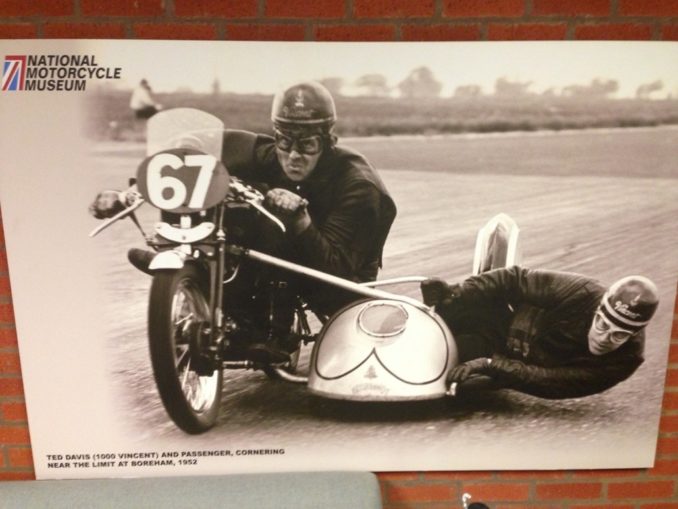
(Picture courtesy of Ernest Allen)
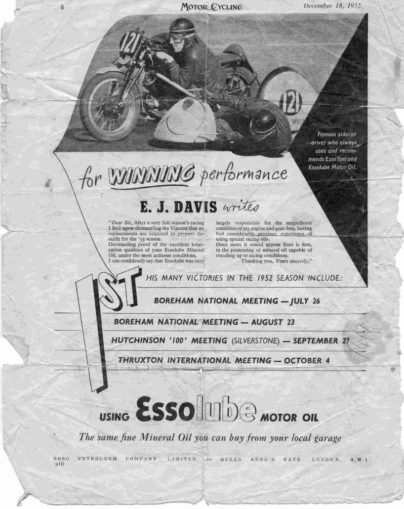
(Scan courtesy of Ernest Allen)
Not many people know that John Surtees on a least one occasion raced his father’s Vincent /Watsonian combination – with Ernie Allen as passenger. Ernie tells the tale of how in 1952 at a sprint meeting at Trent Park in which he and Ted were competing, John Surtees approached him to ask if he could help him out as his passenger hadn’t turned up. After consultation with the race officials this was deemed permissible so, after Ted and Ernie had made their run Ernie did another stint in the chair, this time with John. With Ted and Ernie taking first place and John and Ernie second, Ernie lays claim to being the only person ever to have come first and second in the same race.
Ted and Ernie had another very successful season in 1953 and decided to enter the Isle of Man TT the following year, the first meeting after the War. Sadly at a meeting at Crystal Palace on Easter Monday 1954 while using a Canterbury sidecar with a sprung wheel for the first time, the duo had the only serious crash of their career when Ted clipped the kerb while taking a bend a little too enthusiastically and they hit a steel signpost that was surrounded by bales of straw. Ted flew over the handlebars and Ernie was thrown high into the air landing on the otherwise uninjured Ted breaking his fall but sadly also breaking Ted’s right arm. Unfortunately, the arm never healed properly with the result that Ted no longer had sufficient strength to steer the combination with its ‘Girdraulic’ forks at or near the limit.
Another blow had come when they discovered that the TT rules restricted the capacity of bikes to 500cc ruling out their Vincent combination which would have been ideally suited to the mountainous section of the course. Norton were unable to supply a suitable works machine so they ended up with a Matchless G45 with a specially made Canterbury racing chair that, according to Ernie, was beautifully constructed but far too heavy to be competitive. Nevertheless, only four weeks after their accident and against some very stiff competition they found themselves in fifth place behind the top two British and two German works duos when the Matchless’ left exhaust pipe vibrated loose and fell trailing on the ground in a shower of sparks. Ernie to this day doesn’t know how he managed to wrestle the red hot pipe off the bike and into the sidecar but any chances they might have had of glory now disappeared and they finished the race in 12th place.
By now it was clear that despite trying to augment his steering by using a foot on the handlebars, Ted’s competitive racing days were over and regretfully they decided to retire from the scene and sold their ‘Lightning’ combination to Chris Warner for £475.
When Vincent Engineering folded, Ted Davies became an engineering consultant for Borg Warner automatic transmissions and Ernie eventually set up a successful business importing and selling spares for European cars.
The Vincent Owners’ Club
One of the things that struck me while listening to Ernie’s story was his regret at never having been fully recognised for his racing achievements. As was the practice in those days, the man in the chair, despite his acrobatic performances during the race, was referred to simply as ‘the passenger’ so all the accolades went to ‘Ted Davies and passenger’ with no mention of Ernie Allen who, if you recall, was an equal owner/partner in the team. Ernie also said that he would love to have the opportunity to chat to some Vincent enthusiasts and possibly to hear a twin running again.
This got me thinking so without telling him, I emailed the Vincent Owners’ Club (VOC) Secretary giving him the bare bones of the story. A couple of weeks later, I was delighted to receive a message from the Dorset branch of the VOC inviting Ernie and me to one of their monthly meetings at which Ernie would be the guest of honour. One of the VOC members even picked us up from our homes and drove us to Wool where we were made very welcome. The members bombarded Ernie with questions about his time at Vincent’s and his racing career with Ted Davies.
We had a very enjoyable night out and it was a great pleasure to see Ernie enjoying himself so much reliving his racing days in front of such an appreciative audience.
And so far as I was concerned, that was the end of the story.
A phone call from out of the blue
A few weeks after the VOC branch meeting however, Ernie told me that he had received a telephone call from someone asking if he was ‘the Ernie Allen’. Mystified, Ernie asked what the caller meant and it soon became clear that he had seen an article in the VOC newsletter about our visit to the Wool meeting. The caller said that he currently owned Ted and Ernie’s ‘Lightning’ and furthermore offered to bring it to Ernie’s home for him to have a look at.
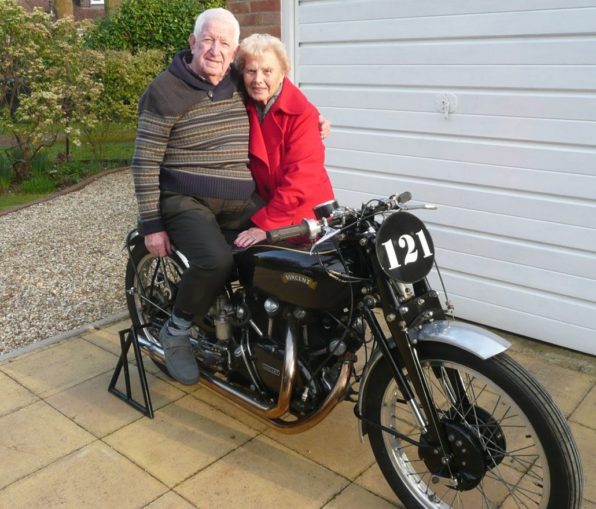
© Tom Pudding 2020
Not long afterwards a trailer bearing two Vincent ‘Lightnings’ both of which had been previously owned and raced by Ted Davies turned up and I was invited round to meet the owners and to take pictures.
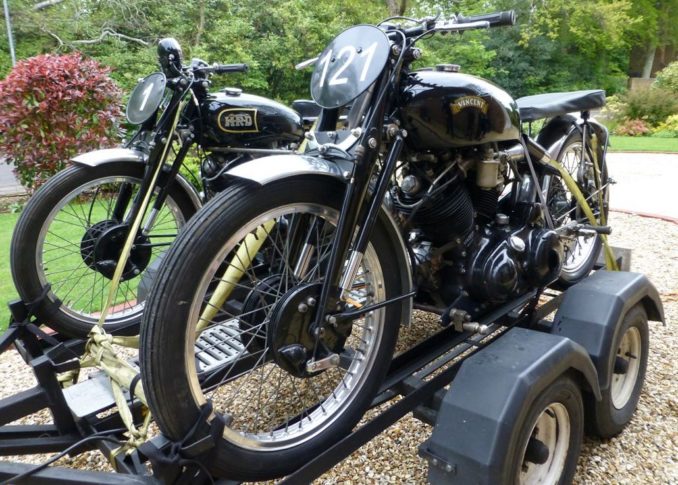
© Tom Pudding 2020
From this meeting a deep friendship developed between Ernie, Maisie, Ted’s daughter Annie (with whom Ernie and Maisie had maintained contact over the years) and the new owners of the racing Vincent.
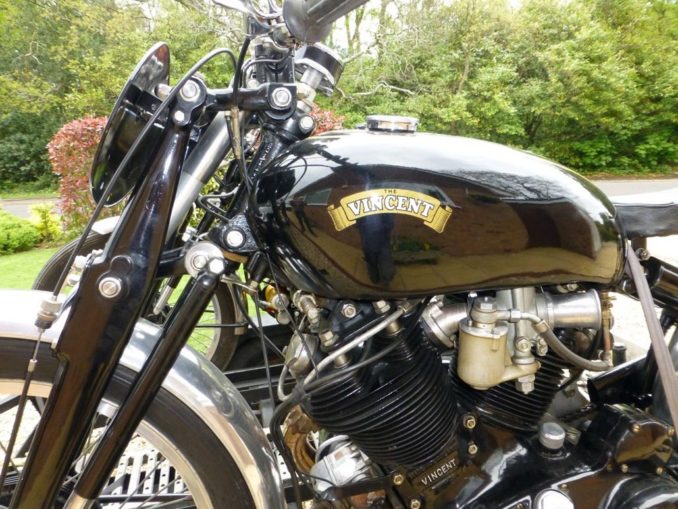
© Tom Pudding 2020
And once again I thought that was the end of the story – but how wrong can you be?
The combination is reborn
Between them, Ernie and Annie Davies (since sadly deceased) had amassed a large archive of material relating to Ted and Ernie’s racing career and Vincent motorcycles in general including many pictures of their sidecar. No one knows what happened to the Watsonian chair that Ernie raced in but the new owners of the ‘Lightning’ were determined to recreate the race-winning combination by building a replica. Amazingly, the original plans had been retained by Watsonian so, with the company’s consent, highly respected engineer, Vincent enthusiast and sidecar racer ‘Tommo’ Thompson was engaged to fabricate an exact replica. The resulting chair is absolutely stunning and in 2016 the immaculate Vincent combination was ready to grace the track again in its original racing configuration.
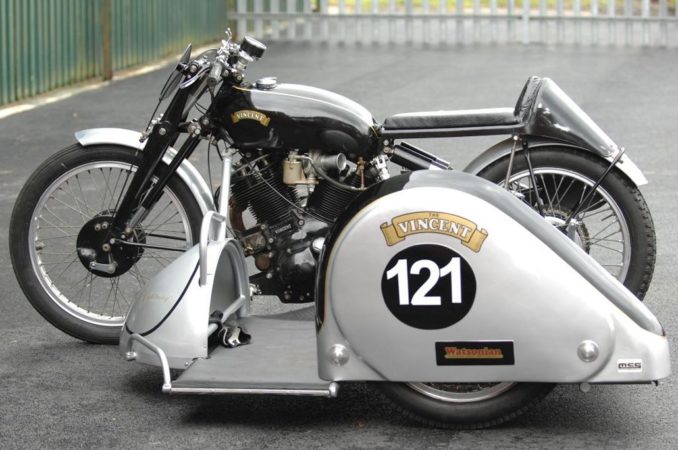
(Picture courtesy of Ernie Allen, ‘Tommo’ Thompson and the new owners)
The icing on the cake came when the owners of the combination invited Ernie and Maisie to attend a track day at Blyton Park Circuit in Lincolnshire where the combination would be demonstrated to representatives of the classic motorcycle press.
Now nothing would induce me to get on the pillion of a road going motorcycle let alone mount the chair of a racing combination but Ernie couldn’t wait to get the leathers on again and hit the track. His words to Tommo before they set off were, “Let it go; you won’t frighten me.”
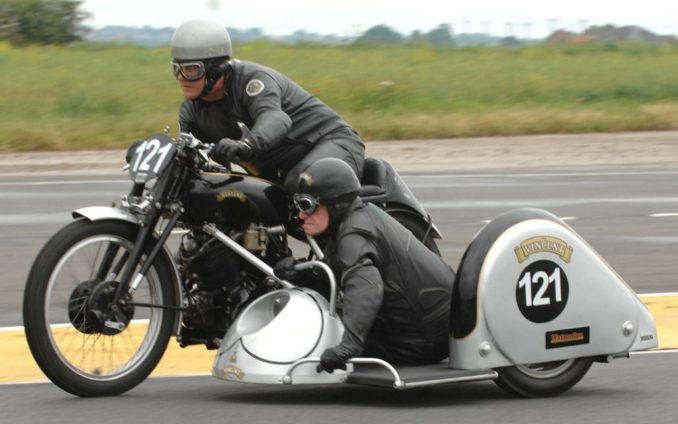
(Picture courtesy of Ernie Allen, ‘Tommo’ and the new owners)
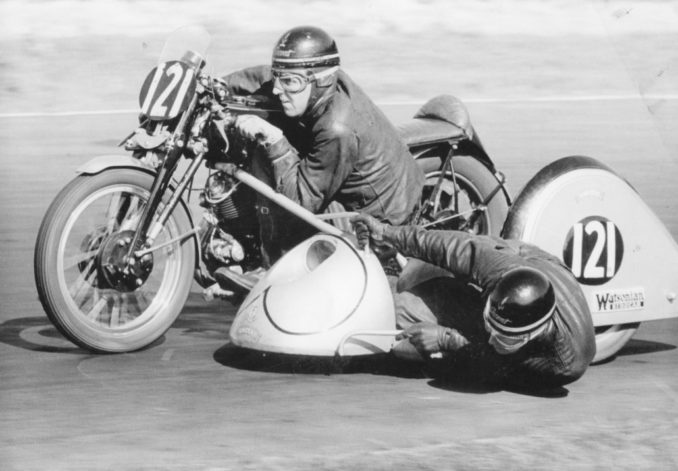
(Picture courtesy of Ernie Allen)
“How did it feel to be in the chair again after 60 years, Ernie?” I asked when he got back.
“It was great and the memories came flooding back,” was the reply, “but I made a few mistakes. When you are in the chair, you listen to the note of the engine and when the driver backs off the throttle, that’s your cue to move out on a left-hand corner and up on a right-hander. You aim to be one inch off the ground when leaning out. With Ted, I was tuned-in to the way he drove and it became second nature but it was more of a challenge with a new driver on a bike he also wasn’t familiar with. No doubt we’d both have got better with practice. Mind you,” he said, “I wasn’t able to get out as far as I used to. I know if I’d tried, I’d never have been able to get up again! Still, it was great fun and I wouldn’t have missed it for anything.”
One of Ernie’s greatest regrets is that due to Ted’s injury and their unscheduled early retirement from competition, he never achieved his ambition to race at Spa in Belgium where he reckons, with the immense pulling power of the Vincent twin, they would have dominated the hilly circuit even against works teams.
The right stuff
We often hear of veteran pilots taking to the sky again in the rear seats of two-seater Spitfires and ex-Paratroopers making tandem jumps while strapped to instructors – but how often do we hear of 88 year old former motorbike racers lapping a racing circuit and reaching speeds in excess of 115 mph while at times only inches from the surface of the tarmac?
If that isn’t true grit then I don’t know what is.
Acknowledgements
I am indebted to the following:
Ernie Allen for his patience with all my questions and for allowing the use of his pictures
The Vincent’s new owners for kindly allowing the use of their Blyton Park Circuit pictures and for making this story possible
Prosper Keating for his advice and encouragement.
© text & images Tom Pudding 2020
The Goodnight Vienna Audio file
Audio Player



